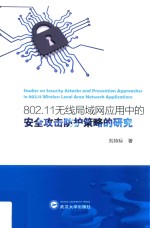图书介绍
802.11无线局域网应用中的安全攻击防护策略的研究PDF|Epub|txt|kindle电子书版本网盘下载

- 刘持标著 著
- 出版社: 武汉:武汉大学出版社
- ISBN:9787307173842
- 出版时间:2016
- 标注页数:233页
- 文件大小:21MB
- 文件页数:249页
- 主题词:无线电通信-局部网络-安全技术-研究
PDF下载
下载说明
802.11无线局域网应用中的安全攻击防护策略的研究PDF格式电子书版下载
下载的文件为RAR压缩包。需要使用解压软件进行解压得到PDF格式图书。建议使用BT下载工具Free Download Manager进行下载,简称FDM(免费,没有广告,支持多平台)。本站资源全部打包为BT种子。所以需要使用专业的BT下载软件进行下载。如BitComet qBittorrent uTorrent等BT下载工具。迅雷目前由于本站不是热门资源。不推荐使用!后期资源热门了。安装了迅雷也可以迅雷进行下载!
(文件页数 要大于 标注页数,上中下等多册电子书除外)
注意:本站所有压缩包均有解压码: 点击下载压缩包解压工具
图书目录
CHAPTER 1 Introduction1
1.1 Motivations1
1.2 Crypto attacks on WLANs2
1.2.1 Traffic analysis2
1.2.2 Eavesdropping4
1.2.3 Man-in-the-middle5
1.2.4 Session hijack6
1.2.5 Masquerading7
1.2.6 Unauthorized access7
1.2.7 Replay(or Playback)8
1.2.8 Tampering9
1.2.9 Forgery10
1.3 Approaches to resolve crypto attacks10
1.3.1 Wired equivalent privacy10
1.3.2 802.11i(TKIP,CCMP)14
1.3.3VPN solution against crypto attacks21
1.4 Denial of service(DoS)22
1.5 Related DoS research work25
1.6 Proposed approaches and contributions26
1.6.1 Contributions to resolve crypto attacks26
1.6.2 Contributions to resolve DoS attacks27
1.7 Outline27
CHAPTER 2 Experimental Methodologies35
2.1 Summary of tools35
2.1.1 Pcattcp36
2.1.2 WireShark36
2.1.3 FreeRadius server36
2.1.4 HostAP36
2.1.5 Void11 attacking tool37
2.1.6 Wireless sniffer38
2.1.7 Network simulation38
2.2 Performance measurements38
2.2.1 TCP throughput38
2.2.2 Round trip time40
2.2.3 TCP time-sequence graph40
2.2.4 UDP throughput and packet loss41
2.3 Experimental design42
2.3.1 Network emulation of AuthRF and AssRF attacks42
2.3.2 Network emulation of DeauthF/DisassF attacks43
2.4 Queuing model44
CHAPTER 3 Protect Wireless LANs using VPN over 802.11i49
3.1 Introduction49
3.2 Five S problems of enterprise WLANs50
3.2.1 Security attacks on wireless communication(SAOWC)51
3.2.2 Stealing wireless resources(SWR)52
3.2.3 Sniffing internal traffic(SIT)52
3.2.4 Sharing internal resources(SIR)53
3.2.5 Security backward compatibility(SBC)53
3.2.6 Summary of 5S problems53
3.3 Security approaches for five S problems54
3.3.1 WEP54
3.3.2 WEP-802.1X55
3.3.3 VPN/WEP-802.1X55
3.3.4 802.11i(TKIP,CCMP)56
3.3.5 VPN over 802.11i(TKIP,CCMP)57
3.3.6 Summary of security approach58
3.4 Experiments and methodologies59
3.5 Performance analyses60
3.5.1 Throughput vs.security measures60
3.5.2 Overheads of security approaches61
3.5.3 Performance of VPN/802.11i-TKIP62
3.6 Theoretical analyses of performances63
3.6.1 Theoretical analyses of WLAN throughputs63
3.6.2 Analysis of packet encryption time65
3.6.3 Analysis of packet transmission time65
3.6.4 Performances of VPN/802.11i66
3.7 Conclusions68
CHAPTER 4 AuthRF and AssRF DoS Attacks72
4.1 Empirical study of AuthRF and AssRF attacks72
4.1.1 Hardware sensitivity74
4.1.2 Traffic sensitivity75
4.1.3 Empirical study of AuthRF/AssRFon TCP traffic75
4.1.4 Empirical study of AuthRF/AssRF on UDP traffic77
4.2 Queuing models of WLANs79
4.3 Qualitative performance analyses83
4.3.1 Data and management frame flows under AuthRF/AssRF84
4.3.2 Difference between upstream UDP and other data streams85
4.3.3 AuthRF/AssRF effects vs.attacking rates85
4.4 Quantitative performance analyses87
4.4.1 Analysis of TCP RTT88
4.4.2 Analysis of UDP packet loss90
4.5 Discussion of performance results93
4.5.1 TCP performance results95
4.5.2 Upstream UDP packet loss96
4.5.3 Downstream UDP packet loss97
4.5.4 Data sending rate sensitivity analysis99
4.6 Approaches to resolve DoS attacks100
4.6.1 Request authentication101
4.6.2 Reduction of duplicate requests102
4.6.3 Reduction of response retransmission103
4.6.4 Round robin transmission105
4.6.5 Comprehensive performance study of RA,R DR,RRR and RRT106
4.6.6 Comparisons of RA,RDR,RRR and RRT109
4.7 Conclusions110
CHAPTER 5 DeauthF and DisassF Attacks113
5.1 Effects of DeauthF and DisassF on traditional WLANs113
5.1.1 DeauthF/DisassF hardware sensitivity113
5.1.2 DeauthF and DisassF attacks on TCP/UDP traffic114
5.1.3 802.11 operations under RAP attacks116
5.2 802.11w-Protection of management frames118
5.2.1 802.11w standard background118
5.2.2 802.11w implementation120
5.2.3 Validation of 802.11w implementations122
5.2.4 Evaluation of 802.11w124
5.3 STA-based queuing model126
5.4 Qualitative analysis128
5.4.1 TCP data flow128
5.4.2 UDP data flow130
5.4.3 Analysis of TCP RTT and UDP packet loss130
5.5 Approach to resolve DeauthF/DisassF attacks132
5.6 Conclusions135
CHAPTER 6 RAP DoS Attacks with Markov Chain Model137
6.1 Introduction137
6.2 Experimental methodologies138
6.2.1 WLAN DoS experiments138
6.2.2 WLAN DoS simulation139
6.3 Theoretical studies of DoS attacks140
6.3.1 Markov chain model140
6.3.2 Wireless client Markov chain model140
6.3.3 Analyses of DeauthF and DisassF142
6.4 Implementation of 802.11w143
6.4.1 Deauthentication and disassociation frames143
6.4.2 Hash function for authentication144
6.4.3 Encryption mechanisms for authentication144
6.5 Analyses of 802.11w145
6.5.1 Normal WLAN145
6.5.2 WLAN under DeauthF145
6.5.3 802.11w-enabled WLAN under DeauthF146
6.5.4 802.11w-TPF enabled WLAN under DeauthF147
6.5.5 Summary of four cases148
6.6 Conclusions149
CHAPTER 7 DoS Attacks against Wireless VoIP150
7.1 Introduction150
7.2 Backgrounds of DoS attacks on WVoIP152
7.3 Experimental Design of WVoIP155
7.4 DoS attacks on WVoIP157
7.4.1 Authentication request flooding attack on WVoIP158
7.4.2 Association request flooding attack over WVoIP160
7.4.3 RAP based deauthentication flooding attack over WVoIP161
7.4.4 RAP based disassociatiot flooding attack164
7.4.5 Solutions to DoS attacks on WVoIP166
7.5 Conclusions170
CHAPTER 8 Layer-3 Forwarding on Wireless LANs172
8.1 Introduction172
8.2 Bridging with layer-3 forwarding176
8.2.1 Layer-2 bridging and IP routing176
8.2.2 Layer-3 forwarding(L3F) process177
8.3 Experimental design178
8.4 Performance results181
8.5 Conclusions183
CHAPTER 9 Wireless Device Server Based Sensor Management Systems186
9.1 Introduction186
9.2 Wireless device server based management system188
9.2.1 Multiple tier and hierarchy architecture of WDSBISFMS189
9.2.2 WDSBISFMS functionalities190
9.2.3 WDSBISFMS implementation examples192
9.3 Application examples of WDSBISFMS193
9.3.1 WDSBISFMS for fixed sensors193
9.3.2 WDSBISFMS for mobile sensors194
9.3.3 WDSBISFMS for airplane imaging system196
9.3.4WDSBISFMS for monitoring data center197
9.4 Sensor technologies and sensor management standardization199
9.5 Conclusions200
CHAPTER 10 Summary of Contributions and Future Works202
10.1 Contributions on the experimental studies202
10.1.1 Design of experiments202
10.1.2 Data collection and performance metrics203
10.1.3 Enhancement of tools204
10.1.4 Enhancement of NS-2 simulations204
10.2 Contributions on the theoretical modeling204
10.2.1 VPN performance overhead analysis204
10.2.2 Queuing model for the authentication and association process205
10.2.3 Queuing model for the deauthentication and disassociation process205
10.3 Solutions to enhance WLAN security205
10.3.1 Integrated solution205
10.3.2 Solutions to AuthRF and AssRF attacks206
10.3.3 Enhancement to 802.11w206
10.4 Future work206
Derivation of Trand Ta208
Derivation of RX response time(t2)210
Derivation of TX2 response time(t5)212